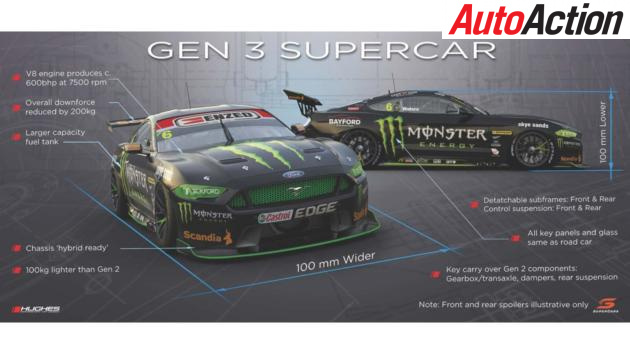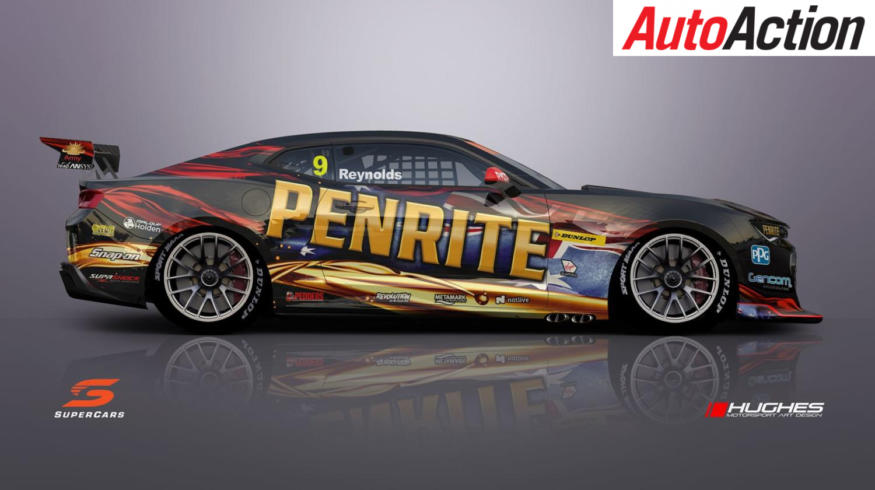SUPERCARS OUTLINES GEN3


A diagram detailing the Gen3 regulations. Image: Supercars
Camaro versus Mustang, a return to road related-looks, still V8s, less aerodynamic downforce and reduced costs.
By MARK FOGARTY
Some of the highlights of the major revamp for Supercars in 2022, key details of which have been announced as the Bathurst 1000 weekend begins.
The headline of Gen3 is the Chevrolet Camaro joining the Ford Mustang on the grid, replacing the Holden Commodore.
But there is a lot more to the story of the next generation of Supercars racers, with new rules aimed at also attracting new manufacturers and cutting the cost of racing.
As long predicted by AUTO ACTION, Gen3 will better accommodate the shape of two-door coupes, which Supercars sees as the medium-term future after more than two decades of primarily four-door sedans.
Loud V8s and rear-wheel drive will remain the foundations, but with provision for electric-assisted hybrid powertrains in the near future.
GM and Ford have endorsed the new rules, with Supercars declaring that the Camaro and Mustang “are slated for the grid in 2022”.
Supercars has also issued renderings of what the Gen3 Camaro ZL1 and Mustang racers will look like.
The aim of Gen3 is to enhance the racing, improve the visual appeal of the cars and make building and running them more affordable for the teams.
According to Supercars, Gen3 “will deliver an evolution of the existing race car platform to transport Supercars into the future”.
It added: “Both the General Motors Camaro ZL1 and Ford Mustang are slated for the grid in 2022, with the Gen3 revamp incorporating a new technical design and a modern look, more closely aligned to the road car.”

GM will continue its participation in Supercars through the Camaro. Image: Supercars
The Gen3 upgrade will include a lower, safer, ‘hybrid-ready’ control chassis that can accommodate a greater range of competing cars, reducing height by 100 m and increasing width by 100 m.
Cars will be 100 kg lighter overall, as well as being simpler and include more control components as part of an overall targeted cost reduction of 30-40 percent.
Parity will continue to be controlled by Supercars, which is aiming to cut overall downforce by 200 kg – a reduction of more than 50 percent – to improve the racing. The size of the rear wing will be noticeably smaller.
The Gen3 rules will stipulate that the racers will have the same key dimensions as the road cars on which their look is based. Components including doors, roof, bonnet and windows will have to be the same look and dimensions as the production versions, resulting in a closer visual connection between race and road vehicles.
This requirement is to avoid the deformed look of the existing Mustang racer and is key to GM allowing the Camaro to race here.
While engine output will be further reduced to 600 horsepower at a retained maximum of 7500 rpm, the power-to-weight ratio will be maintained because of the reduced overall mass.
“Changes to the engine rules are designed to make them cheaper to buy and operate, offer greater engine life, reduce fuel consumption and ensure more engine options can be competitive,” Supercars said.
A Supercars-branded engine option is also under consideration, potentially reducing barriers to entry for new brands.
The Gen3 design will have the provision for the later adoption of hybrid powertrain technology, adding electric assistance. The existing X-Trac control transaxle is already made to accommodate an electric motor.
A new Dunlop control tyre will be introduced to offer a higher temperature working range and designed around lower downforce levels. A super-soft compound will also be trialled.
Control components will be made available directly from Supercars. Control specification parts may continue to be fabricated by teams or purchased from Supercars.
Front suspension uprights will become standard-design items.
Key carryover components will be the transaxle, dampers and rear suspension.
According to Supercars, “Discussions to secure IP (intellectual property) agreements with additional manufacturers are currently underway”.
Supercars supremo Sean Seamer hailed Gen3 as a major step forward.
“We are thrilled to welcome a brand-new race car design to the track in 2022,” Seamer said in a statement. “The cars will retain their signature V8 engine format to ensure they’re fast and loud, but will be ‘hybrid ready’ and more closely resemble the road cars they are based on.
“These are incredible looking race cars that give a nod to the Supercar of the past, with as much attention given to the design and appearance of the cars as the new technologies.
“The Gen3 project will support the longevity of Supercars by increasing relevance to our fans and partners, reducing operating costs, and making the racing even fiercer.
“The cars will have a lot less downforce than the current car, making the racing more spectacular and putting more reliance on driver skill.”
The Gen3 Committee tasked with the design and definition of the program comprises homologation team representatives Ryan Story (DJRTP) and Roland Dane (Triple Eight), Supercars Commission representative Tim Edwards (Tickford Racing), and Board and Commission representative Brad Jones (BJR), as well as Adrian Burgess and John Casey from Supercars, and technical consultant Carl Faux (WAU).
For more of the latest Supercars news pick up the current issue of Auto Action. Also make sure you follow us on social media Facebook, Twitter, Instagram or our weekly email newsletter for all the latest motorsports news between issues.






